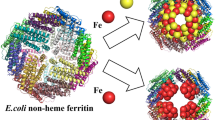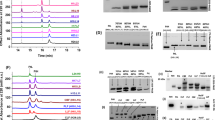Abstract
We purified an iron-containing protein fromCampylobacter jejuni using ultracentrifugation and ionexchange chromatography. Electron microscopy of this protein revealed circular particles with a diameter of 11.5 nm and a central core with a diameter of 5.5 nm. The protein was composed of a single peptide of 21 kDa and did not serologically cross-react with horse spleen ferritin. The UV-visible spectrum of the protein showed no absorption peaks in the visible region, indicating that little or no heme is bound. The ratio of Fe:phosphate ofC. jejuni ferritin was 1.5∶1. From these morphological and chemical examinations, we concluded that theC. jejuni purified protein is a ferritin of the same class as that ofHelicobacter pylori andBacteroides fragilis and differs from the heme-containing bacterioferritin ofEscherichia coli. The 30 N-terminal amino acids were sequenced and were found to resemble the sequences of other ferritins strongly (H. pylori ferritin, 73% identity;B. fragilis ferritin, 50% identity;E. coli gene-165 product, 50% identity), and to a lesser degree, bacterioferritins (E. coli bacterioferritin, 26% identity;Azotobacter vinelandii, 26% identity; horse spleen ferritin 30% identity). Proteins that cross-reacted with antiserum against the ferritin ofC. jejuni were found in otherCampylobacter species and inH. pylori, but not inVibrio, E. coli, orPseudomonas aeruginosa.
Similar content being viewed by others
References
Andrews SC, Smith JMA, Yewdall SJ, Guest JR, Harrison PM (1991) Bacterioferritins and ferritins are distantly related in evolution. Conservation of ferroxidase-centre residues. FEBS Lett 293:164–168
Briat JF (1992) Iron assimilation and storage in prokaryotes. J Gen Microbiol 138:2475–2483
Chen M, Crichton RR (1982) Purification and characterization of a bacterioferritin fromAzotobacter chroococcum. Biochim Biophys Acta 707:1–6
Doig P, Austin JW, Trust TJ (1993) TheHelpylori 19.6 kDa protein is an iron-containing protein resembling ferritin. J Bacteriol 175:557–560
Frazier BA, Pfeifer JD, Russell DG, Falk P, Olsen AN, Hammar M, Westblom TU, Normark SJ (1993) Paracrystalline inclusions of a novel ferritin containing nonheme iron, produced by the human gastric pathogenHelicobacter pylori: evidence for a third class of ferritin. J Bacteriol 175:966–972
Grossman MJ, Hinton SM, Minak-Bernero V, Slaugh C, Stiefel EI (1992) Unification of the ferritin family of proteins. Proc Natl Acad Sci USA 89:2419–2423
Halliwell B, Gutterridge JMC (1984) Oxygen toxicity, oxygen radicals, transition metals and disease. Biochem J 219:1–14
Hudson JA, Andrew SC, Hawkins C, Williams JM, Izuhara M, Meldrum FC, Mann S, Harrison PM, Guest JR (1993) Over-production purification and characterization of theEscherichia coli ferritin. Eur J Biochem 218:985–995
Izuhara M, Takamune K, Takata R (1991) Cloning and sequencing of anEscherichia coli K12 gene which encodes a polypeptide having similarity to the human ferritin H subunit. Mol Gen Genet 225:510–513
Kurokawa T, Fukumori Y, Yamanaka T (1989)Nitrobacter winogradskyi cytochromeb-559: a nonheme iron-containing cytochrome related to bacterioferritin. Biochim Biophys Acta 976:135–139
Laemmli UK (1970) Cleavage of structural proteins during the assembly of the head of bacteriophage T4. Nature 227:680–685
Lankford CE (1973) Bacterial assimilation of iron. Crit Rev Microbiol 2:273–331
Laulhere JP, Laboure AM, Briat JF (1989) Mechanism of the transition from plant ferritin to phytosiderin. J Biol Chem 264: 3629–3635
Laulhere CE, Laboure AM, Wuytswinkel O van, Gagnon J, Briat JF (1992) Purification, characterization and function of bacterioferritin from the cyanobacteriumSynechocystis PCC6803. Biochem J 281:785–793
Lowry OH, Roseborough NJ, Farr AL, Randall RJ (1951) Protein measurement with the Folin phenol reagent. J Biol Chem 193:265–275
Mann S, Bannister JV, Williams RJP (1986) Structure and composition of ferritin cores isolated from human spleen, limpet (Patella vulgata) hemolymph and bacterial (Pseudomonas aeruginosa) cells. J Mol Biol 188:225–232
Moore GR, Mann S, Bannister JV (1986) Isolation and properties of the complex nonheme-iron-containing cytochromeb-557 (bacterioferritin) fromPseudomonas aeruginosa. J Inorg Biochem 28:329–336
Morooka T, Umeda A, Amako A (1985) Motility as an intestinal colonization factor forCampylobacter jejuni. J Gen Microbiol 131:1973–1980
Rocha ER, Andrew SC, Keen JN, Brock JH (1992) Isolation of a ferritin fromBacteroides fragilis. FEMS Microbiol Lett 95:207–212
Stiefel EI, Watt GD (1979)Azotobacter cytochromeb-557.5 is a bacterioferritin. Nature 279:81–83
Treffry A, Harrison PM (1978) Incorporation and release of inorganic phosphate in horse spleen ferritin. Biochem J 171:313–320
Towbin A, Staelin T, Gordon J (1979) Electrophoretic transfer of proteins from polyacrylamide gels to nitrocellulose sheets: procedure and some applications. Proc Natl Acad Sci USA 76:4350–4354
Tsugita A, Yariv J (1985) Preliminary results for the primary structure of bacterioferritin ofEscherichia coli. Biochem J 231: 209–212
Watt GD, Frankel RB, Papaefthymiou GC, Spartalian K, Stiefel EI (1986) Redox properties and Mossbaur spectroscopy ofAzotobacter vinelandii bacterioferritin. Biochemistry 25:4330–4336
Yariv J, Kalb AJ, Sperling R, Bauminger ER, Cohen SG, Ofer S (1981) The composition and the structure of bacterioferritin ofEscherichia coli. Biochem J 197:171–175
Author information
Authors and Affiliations
Corresponding author
Rights and permissions
About this article
Cite this article
Wai, S.N., Takata, T., Takade, A. et al. Purification and characterization of ferritin fromCampylobacter jejuni . Arch. Microbiol. 164, 1–6 (1995). https://doi.org/10.1007/BF02568727
Received:
Accepted:
Issue Date:
DOI: https://doi.org/10.1007/BF02568727




